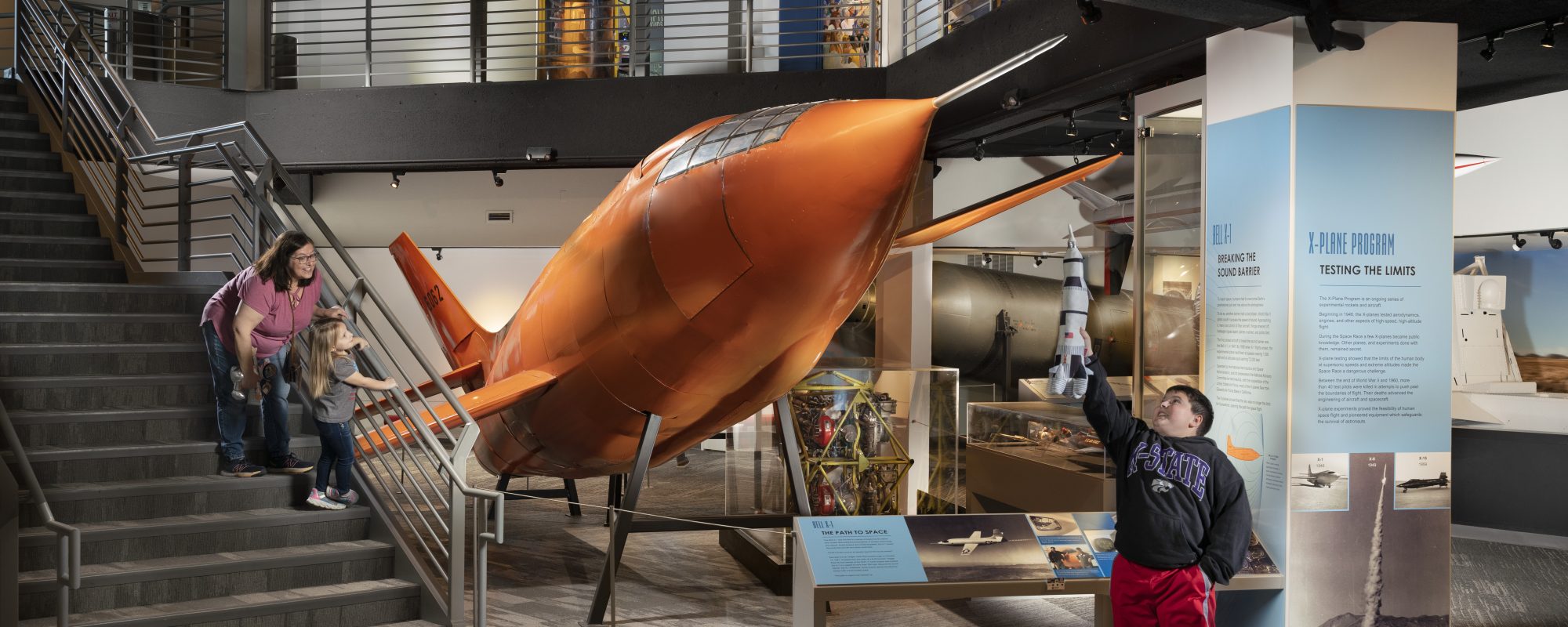Join the Cosmosphere on Thursday, February 18 at 2:20 pm CST as Michael Staab, Cosmosphere Camp alumnus and current Fault Management Systems Principal Engineer for the Lunar Lander and Lunar Gateway programs at Northrop Grumman, joins us for a virtual watch party leading up to the live landing of the next Mars rover: Perseverance. Perseverance is set to land on Mars at 2:55 pm CST. (Landing time is subject to change.)
Perseverance’s mission is to search for ancient life on the Red Planet. Staab will offer insights about the rover and its mission before the landing and commentary during live-streamed NASA event. Following the landing, Staab will take questions from the Cosmosphere’s online audience.
Join this virtual event by visiting cosmowebinar.org or the Cosmosphere’s Facebook page.
To learn more about the Mars 2020 mission, go here.
What happens when two Cosmosphere Camp alums get together to talk about space, science and Mars? You get this amazing article from an insider perspective!
“Landing on Mars”
by Sandy Marshall
I recently met-up with fellow Cosmosphere Counselor alum Michael Staab, an engineer working on NASA’s Artemis mission to the Moon and former MER Flight Director at NASA’s Jet Propulsion Laboratory, to catch-up about the Perseverance Rover’s targeted landing on February 18, 2021.
Tell us about the latest in your world at Northrop Grumman.
I work as the Fault Management and System Autonomy Engineer for Lunar Missions at Northrop Grumman, with a focus on the Gateway lunar outpost and Lander on NASA’s Artemis mission to return humans to the Moon.
Right now, our team is working on the critical design for the NASA Gateway’s HALO module. HALO is the Habitation and Logistics Outpost, and it will serve as the initial pressurized living quarters for astronauts during expeditions aboard the orbiting Gateway. It’s like a mini space station, providing vital support for a sustainable, long-term human return to the lunar surface…as well as a staging point for deep space exploration.
HALO is about the size of a small studio apartment, and can support a crew of 4 for up to 30 days when NASA’s Orion spacecraft is docked.
Kind-of like a Lunar Base Camp.
Exactly. In my world of fault protection, we’ve been analyzing subsystems, identifying which kind of fault protection monitors are needed, and what sorts of actions need to be taken to protect specific hardware and functions for HALO as a whole. Next-up, we’ll start writing the pseudo code, which is what actually runs the monitors. Then we’ll approach a Critical Design Review in late 2021, which is when we’ll implement the fault protection pieces.
Then we get to the fun part.
Let’s hear about the fun part.
The fun part is when we start testing every part of the system to make sure it’s robust. HALO will have all the things you need to keep the crew alive. It’s got a thermal system, obviously power, and also ECLSS (HALO’s life-support system), avionics…all the things you need to run a spacecraft. And it’s supposed to stay up for 15 years. So we have to determine which faults are most likely going to happen, how we’re going to contain those faults, and what we’re going to do when they’re detected.
And we’re getting closer to having our design finalized, so it’s a really exciting time.
Let’s talk about NASA’s Mars 2020 mission, and the Perseverance rover, which is scheduled to land on February 18, 2021.
Perseverance’s prime mission, which is to obtain samples of Martian soil for eventual return to Earth, is slated to last at least two years.
For the prime mission, Perseverance will land on Mars and study different sites for habitability and potential evidence of past bio signatures. During this exploration, the rover will core sample at least 20 samples of Martian soil using its Sample Caching System, and then deposit these samples somewhere in Jezero crater for eventual pickup by the Mars Sample Return Mission (now under official consideration). Once the team gets past the prime mission in the first 2 years, they’ll pitch what’s called a Mission Extension Proposal. If approved, the scientists will continue to study and explore the region around the Jezero crater.
You were a part of numerous Mars landings as a MER Flight Director at NASA’s Jet Propulsion Laboratory. What’s happening in the final weeks before a landing?
The first three phases of a mission encompass launch, cruise and approach. During the approach phase, which happens during the last couple of weeks before entry, teams on the ground are busy gathering navigational data, finishing systems checks, and making any final course corrections.
They’re also doing last-minute checkouts of the EDL systems. EDL stands for Entry, Descent, and Landing, and is a completely autonomous process: meaning the spacecraft will have the commands it needs for EDL before it enters Mars’ atmosphere. The team is also testing out different cameras and sensors they’ll use for entry and landing. This includes the Landing Vision System, which is part of the new tech that enables terrain relative navigation.
For some of our Mars missions, we actually sent up EDL flight software during the cruise phase, because it’s not typically prepped before launch. The big priority is to complete the launch and the cruise software, and then finish and send the software needed for EDL to the spacecraft.
Then within the final 24 hours before landing, the team holds what’s known as a commanding moratorium. At this point, scientists and engineers are not allowed to send any more commands to the spacecraft because of the time it takes to obtain and analyze data. Any last-minute corrections have to be sent up within 24 hours of EDL.
And what happens during the actual landing?
If you see an image of the spacecraft, you have the white capsule part of it, and then you have this thing on the top called the cruise stage, which will jettison approximately 10 minutes prior to landing. The cruise stage has navigational equipment for space travel, solar arrays for power, and propellant for correction maneuvers during the cruise phase. But those aren’t needed to land on Mars, so we’ll jettison that stage to burn-up in the atmosphere.
When the spacecraft enters Mars’ atmosphere, we’ll hit the EIP, or Entry Interface Point, and begin hypersonic reentry, which lasts for approximately 5 minutes. We’ll then blow a supersonic parachute, which inflates within a couple tenths of a second. The spacecraft will jettison the heat shield, collect images to determine a landing solution through terrain relative navigation, detach from the back shell, and descend on it’s rockets using the assistance of a sky crane backpack.
Once we get touchdown confirmation, the rover autonomously fires a set of pyros that cut the wires holding the sky crane, which then flies off and crashes away from the vehicle.
And what happens in Mission Control?
Definitely lots of cheering.
The spacecraft uses tones on the ultra-high frequency spectrum to let us know when a certain event has been completed. For example, when we detect heat shield deployment, there’ll be a tone that the rover’s telecom system will send up through a UHF signal that’ll be received by an orbiter and relayed to Earth.
This is typically the most exciting and nerve-wracking part because of the distance between Earth and Mars. When we get the first indications that the spacecraft has touched Mars’ atmosphere and that we’re starting to slow down, it’s already been on the surface for seven minutes. This is known as the seven minutes of terror. With EDL, we go from roughly 12,000 miles per hour to about one mile an hour when we touch the surface.
And that’s all done autonomously.
What’s the best way for people to stay involved with the Mars 2020 mission?
Everyone can visit the mission site at mars.nasa.gov/mars2020. The hub even includes a landing countdown, but it’s important to keep in mind that we can model with really good precision, but not exact accuracy. There’s a lot of variability in Mars’ atmosphere, so the actual touchdown might be plus or minus a few seconds.
I’ll also be giving a virtual presentation to the Los Angeles Section of the American Institute of Aeronautics and Astronautics on February 13th, here, about Mars Entry, Descent and Landing. That’ll be a nice lead-up to the Cosmosphere’s Perseverance landing broadcast I’ll be hosting on February 18th.
But I think the most exciting part of this mission is the sample caching portion, and being able to finally collect return samples from Mars. Another neat element on the rover is an instrument called MOXIE, which stands for Mars Oxygen ISRU Experiment. MOXIE was developed by a Professor at MIT, and it’s testing an instrument that can convert Mars’ carbon dioxide atmosphere into oxygen. That’s one of the big technologies in The Martian: being able to convert Mars’ atmosphere into breathable oxygen.
For an engineer, that’s pretty cool. I remember when I was watching the Mars Pathfinder mission and Sojourner rover land on July 4, 1997. That’s when I knew I wanted to work on interplanetary spacecraft and do what I’m doing today.
The amazing thing about these missions is that they’re like any great action movie you’ve ever seen…except the missions are real, and they’re actually happening.
It is incredible to think about watching a rover actually land on Mars.
These things only happen once or twice every decade.
The Perseverance Rover is basically a car that we’re landing on another planet. And it’s run completely by computers with ones and zeros.
It’s pretty amazing.
—-
Michael Staab (@AstroStaab) serves as Fault Management and System Autonomy Engineer for Lunar Missions at Northrop Grumman, and is a former MER Opportunity Flight Director. Michael holds a B.S. in Aerospace Engineering from Wichita State University, a M.S. in Aerospace Engineering from the Georgia Institute of Technology. He is an Aerospace Engineering Duty Officer for the United States Navy, aspiring Astronaut, and former Cosmosphere Camps counselor.
Sandy Marshall (@MarshallSandy) is an Emmy-nominated writer/producer, business speaker, TV/film actor (Odd Squad, The Dilemma), and consultant. A longtime space enthusiast, Sandy is Solar System Ambassador volunteer for NASA’s JPL, and co-creator of REACH: A Space Podcast for Kids. He holds a B.A. in History from Drake University (where he later served on the Board of Trustees), and is a former Cosmosphere Camps counselor.


